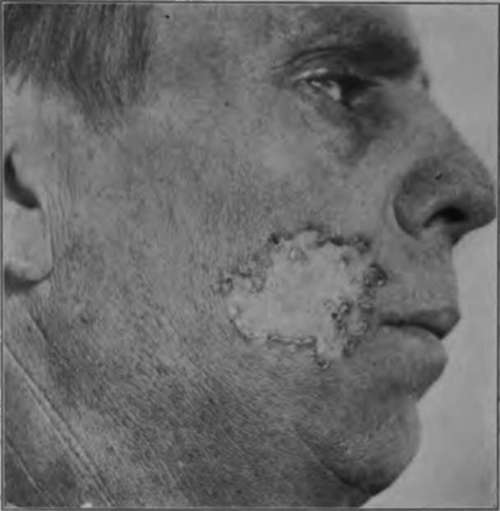V. Morphea-Like Cancer
Description
This section is from the book "Skin Cancer", by Henry H. Hazen, A.B., M.D.. Also available from Amazon: Skin Cancer.
V. Morphea-Like Cancer
Clinical Course
The morphea-like cancel's have recently been described in detail by Heidingsfeld.5 who has collected all of the reported cases in addition to describing one of his own. According to Heidingsfeld, there arc now but eight cases of this variety of cancer on record, but he calls attention to the fact that many cases of so-called ulcerating morphea should undoubtedly be put in this category. Cases have now been described by Danlos,* Stelwagon,*

Fig. 29.-This morphea-like epithelioma showed upon histological examination typical basal-celled structure. (Heidingsfeld's collection).
*Heidingsfeld: Jour. Cutan. Dis., 1913, xxxl. 379. "Danlos: Ann. de dermat. et de syphil.. 1899, x, 666. 'stelwagon: Trans. Amer. Deimat. Assn.. 1899. 166.
Hartzell,* Fordyce,* Pernet,* and Heidingsfeld, and all of these authors feel that the cases are not especially rare, but that they arc frequently overlooked. These lesions usually start as small nodules, situated upon the temples or malar eminences, but occasionally on the body. They are sharply defined and spread very slowly, it often taking four or five years for one to reach the diameter of 2 cm. When seen by the dermatologists, they are sharply-defined lesions, often with a slightly elevated pearly border. The center is white or yellowish-white, and is depressed. The violet hue, characteristic of scleroderma, is lacking, but there are dilated blood vessels running over the surface. The edge is very hard to the touch, and the center feels leathery (Fig. 29). There may or may not be small or fairly large ulcerated areas, either at the edge or nearer the center of the neoplasm. Pernet described the feel of the tumor as comparable to that of a coin imbedded in chamois beneath the skin, but other authors seem to think that it is not so hard as this. The tumors run the same course as any of the other slow-growing rodent ulcers.
Pathology
Histologically, these neoplasms are usually of the acinous basal-celled type, undoubtedly starting as solid alveoli.
Diagnosis
Morphea, or possibly syphilis or lupus erythema-tosis, might be confused with them.
Continue to:
Tags
bookdome.com, books, online, free, old, antique, new, read, browse, download
